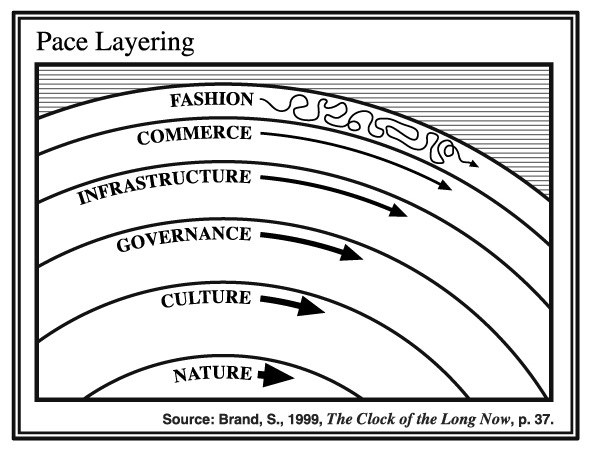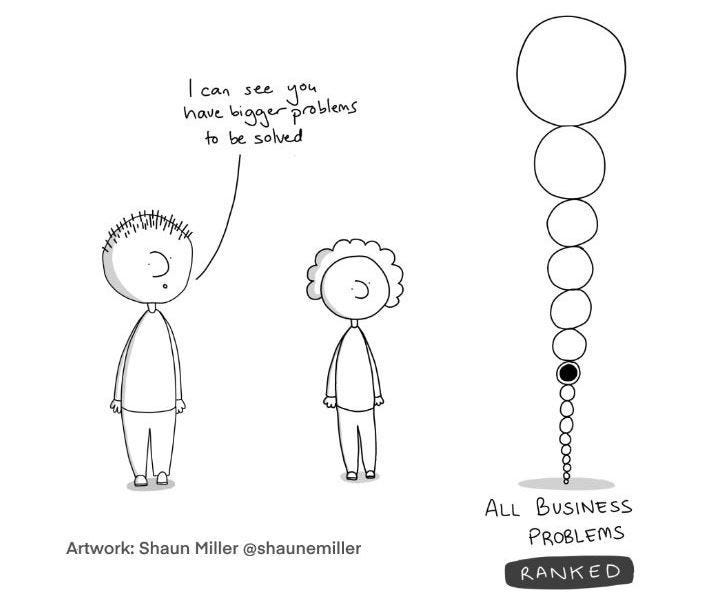#71 - Understanding change and stepping out of the shadow of outcomes
Plus finding the most important thing for you
Hello, readers! Welcome to issue #71 of Curiosity > Certainty 👏
We take our two-year-old to the pool on a weekday. It’s a lovely evening and she enjoys herself like only two-year-olds can do. We remind each other and our friends who have accompanied us: we should do this more often.
The drive back takes 90 minutes. It should not. It is only a few kilometers. The city is dug up. Metro lines are everywhere, leaving the roads in a perennial state of becoming. The fact is that the city has been like this for years, creeping up on double digits now.
That time’s enough for someone to have had a career. We’ll be parents of a toddler for only a couple of years more.
An individual makes an effort to be better every week. The city does so too. But it takes a decade. Caught in such a cycle, the individual feels trapped in an endless tunnel. Is this all there’s to it, she asks.
The city’s moving as fast as it can. Only the math is different. The smallest unit of infrastructural change is orders of magnitude bigger than that of individual change.
It was the discovery of a certain greenish rock (malachite) that ended the Stone Age. When put in a very hot fire, malachite turned into a piece of precious metal–copper. Copper tools birthed civilizations and cities in the ancient world. They ushered in the Copper Age. Copper is a poor choice, with today’s understanding of metallurgy, for sculpting rock. It is too soft. But it was the best humans had for four millenia. Until the Bronze Age.
For two decades of those four thousand years, tens of thousands of workers in ancient Egypt spent their days carving out pyramids from rocks using copper tools. If you were one of them, you would be forgiven for wondering if there was a finish line. On you fell the onus of carrying through a project too grand with tools too crude.
And you soldiered on.
You, the reader, are no different from that copper wielder millenia ago. You’re at the frontier of what you’re trying to do in this world. Yet, it feels like the world’s taking ages to catch up with you. Any innovator, pioneer, or activist knows this.
True change goes far. The only way out is in. If you believe in something, go all in.
Design a better life for yourself by understanding one concept
Think of the organization you work at. At its core is a mission. It is the lens through which you and other employees like you view the world. It doesn’t change.
Coinbase wants to increase economic freedom; Stripe, increase GDP of the internet; and Amazon, be the earth’s most customer-centric company.
To fulfill such a mission, the org nurtures a culture. Stripe has radical transparency. Amazon has two-pizza teams. Culture too is slow to change but could conceivably do so in the face of big market shifts.
Then there’s the governing structure. It’s plausible to have org restructuring every few years–new CEO, new business heads?–to be better set up for success.
And finally come business models–what’s the best way to make a profit?–and they are often aligned with customer habits, which are evolving all the time.
With each outer layer, change quickens. There are more things calling out the farther out you look. Yet, power rests with the lower fundamental layers. They make the foundation on which your business will be built. The foundation carries all the weight.
This analogy explains a concept called pace layering.
First proposed by Stewart Brand, what is pace layering and why should you pay attention to it?
So that you don’t get caught up in superficial change and forget the core that drives any complex system. The most important complex system for you is you.
The outer layers are reflections of your thin desires. They are highly mimetic. We want what others want. We do what others do. We wear what others wear.
The innermost layers are thick desires, or at least thicker. They’re independent of what others like us want. It is dangerous to want a new spouse because someone else you follow got themselves a new one.
Where does your attention go over a lifetime? Clothes, cars, property, rank, status? Or job maybe?
But if you lose your job, you only lose your means for commerce. You do not–should not–lose your mind because you still got education, that intermediate layer of intellectual infrastructure to absorb the shock and get you another job. Doesn’t that mean you should pay more attention to your education, to self development?
In his original model, Brand chose from the outside in fashion, commerce, infrastructure, governance, culture, and nature as the layers. His choice is only a taxonomy. You can use its principle to deconstruct any complex system.
The most important complex system for you is you.
You don’t lack compassion. You lack hygiene.
When it comes to judging the quality of decisions, you may fall prey to resulting: you judge decision quality by outcome quality.
For example, you may assess: a bad outcome = a bad decision
You may be tempted to think less of a colleague or a team member if their efforts have led to a poor outcome.
You chalk the poor outcome up to their character (how good they are) and ignore the circumstances. You discredit their preparation and their thinking by tracking only the outcome and little else.
When this happens, your colleagues may see themselves as hard done by. ‘What a jerk!’ they may wonder about you.
But you’re hardly a jerk. You’re just following your own flawed internal algorithm: good outcome = good decision; bad outcome = bad decision.
You don’t examine decisions. You let the outcome cloud your judgment about the quality of the decision. You forget that sometimes a good decision can precede a bad outcome because of bad luck!
By ignoring the role of luck, you blame others squarely for how things turn out. ‘You should have thought this through’ is your harsh message to them.
When others complain, you point out that you demand the same of yourself. ‘I have the same high standards for myself.’
You’re not lying. You beat yourself up when things don’t go your way. This may be especially true if you’re a high achiever.
Yet, this has got nothing to do with your standards (as you think) or your lack of compassion (as the world thinks).
The unexamined life is not worth living, said Socrates. He may have been talking about resulting.
Luck can loosen the relationship between decision quality and outcome quality. It sometimes crosses the wires–connects a good outcome to a bad decision and a bad outcome to a good decision.
💡You’re likely to draw wrong conclusions about your self-worth and that of others if you ignore luck. Ignoring luck is a sign of poor decision-making hygiene. It reveals you don’t study your decisions. So, you end up not learning from experience–or worse, learning the wrong lessons!
The good news is that you’re not unkind. The bad news is that the world’s going to disagree with that until you do something about it.
Stack Ranking Your Objectives
Customer Problem Stack Ranking from Shreyas Doshi is a way out of the problem of working on problems that almost no one cares about.
You rank customer problems in a stack so that you know what is most important to solve. Otherwise you get sucked into a cycle of get product idea, do promising user research, launch product, find no takers, do more research, launch v2, and so on.
After every such cycle, you walk away a little more bemused yet confident that you’ve learned something. What you should learn is this:
💡‘Nothing in life is as important as it is while you’re thinking about it.’ This is something that Daniel Kahneman calls the ‘focusing illusion’ (link in comments)
💡The focusing illusion improves on the painkiller v vitamin v candy theory. It says in the thick of it even candy can seem like a painkiller. How?
By inducing tunnel vision. When something is in focus, you only see that and nothing else. Candy, candy, candy!
Stack ranking can get you out of this rut. Here’s where it gets exciting.
Like most good ideas, it travels well outside of the domain it was thought of. You can use the same principle to make better decisions for yourself.
👉When making a decision, list all objectives that mean anything to you. Scribble one each on a post-it.
👉Pick one that seems most important and another to battle it with.
👉Compare the two–which matters more?
👉Then pick up another post-it against the winning objective.
👉As you do, add weights–how far are you willing to go for an objective? You want a dog but not if your spouse is threatening to leave you because of it.
Once you’re through the stack ranking, you’ll have identified the most important thing.
But wait, you thought you didn’t need this ranking stuff, did you?
The focusing illusion affects us all. You’re no different from a shifty customer. You’ve the same problem. You don’t know what you want. You think you do, but catch you at a different time of the day and your wedding plans will have made an about turn.
It is a skill to know and name what you want. Once you’re clear on what’s important to you, it’s harder to be sidetracked by the false compass of peer pressure, changing trends, or anything that doesn’t sit right with your values.
As I said, stack-ranking travels well. Allow it to help you elsewhere as well: a boss who seems to not know what she wants, a choice between two jobs, or even whether to get a cat since the dog didn’t work out…
***
Thank you for your time! If you’re piqued by Daniel Kahneman’s focusing illusion, you can dive into it here. If you try any of the shared strategies, I would love to know how that works out for you. And finally, let me know how I can make this newsletter more useful for you. Comments are open, so is my inbox (satyajit.07@gmail.com). Stay well!





